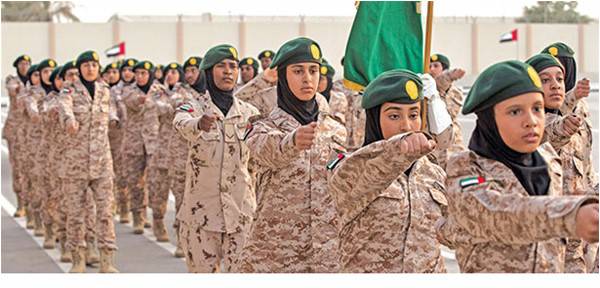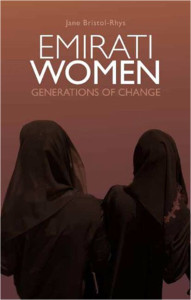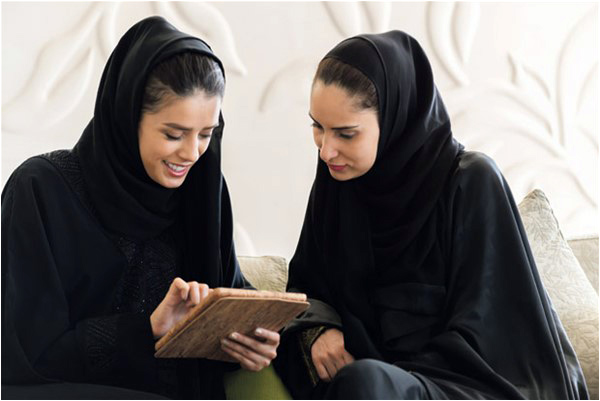

Mention the UAE to anyone who’s ever so much as passed through Dubai airport, and you’re bound to hear a series of clichés about gold fixtures, petrodollars and the lack of culture. There is an entrenched notion of the Emirates as a nation with too much money and too little taste, or that it virtually didn’t exist until the discovery of oil.
It is this set of contentious clichés that Jane Bristol-Rhys takes on in her book Emirati Women, which describes the evolution of social and cultural life in the Emirates, as told through the changing lives of its women. The book confronts the stereotypes of the Emirates that are perpetuated by expats, as well as the revisionist versions of history and culture that have come to dominate the country.
Emirati Women serves as a sharp rebuke to these stereotypes. Jane Bristol-Rhys makes several key distinctions as context. For one, Abu Dhabi defies comparison, because it is an outlier Emirate in its riches. It also didn’t emerge out of an oil well. Abu Dhabi, she notes, was part of the pearl trade route, but it declined after the collapse of pearl trading in the 1920s. And as she points out, there is a need to differentiate between the history of nomadic and settled life in the country.
The author’s work is primarily focused on Abu Dhabi, where she has taught at the Zayed University since 2001, as well as other smaller areas and the emirate of Al Ain. It is in Abu Dhabi that Bristol-Rhys receives an education of about the lives of men and women in the Emirates prior to and after the discovery of oil.
Bristol-Rhys sets out to discover what life was like in the Emirates before it became a nation state; uncovering stories of hardship and poverty, and how those experiences helped build a psyche in the Emirates that enjoyed, to the point of excess, the luxuries - like water - that they had long gone without. Through interviews, she looks at people who once inhabited its oases and cities and honed a communal lifestyle that is on the decline.
Bristol-Rhys sets out to discover what life was like in the Emirates before it became a nation state; uncovering stories of hardship and poverty, and how those experiences helped build a psyche
The primary source of her insight into society is her female students, who offer their opinions on everything from marriage to their place in society as a minority, albeit a protected one. She profiles three generations - her young university students, their mothers, and their grandmothers. It is the latter that forms the most interesting layer of the book, with anecdotes of life in settlements and small towns, and how these women, now grandmothers, perceive their daughters’ dependence on foreign labour. They offer a keen sense of introspection: Could women cope on their own if they didn’t have help? Will their traditions survive? What impact has this dependence on migrants had on the consciousness of Emirati men?
The disconnect between the past and the present is most largely exemplified by the second generation - women who have distant memories of life in the past, and who have benefited the most from Abu Dhabi’s rise.
And it is their daughters who now have an interest in the past, partly from seeing romanticised depictions of life in the desert in television shows, coupled with a keen sense of indignation at how Emirati women are exoticised in contemporary culture. Bristol-Rhys punctuates this sentiment with an anecdote of attending an exhibit with her Emirati students. While the students were looking around, a tourist at the venue started taking photos of them, assuming they were part of the display since the tourist hadn’t seen any local women.
The history of the Emirates is often limited, both at home and abroad, to imagery of Bedouins in the desert. This is a point of sharp critique for Bristol-Rhys, who points out that these traditions and heritage “do not add up to history”, comparing them to snapshots taken out of context.

The author’s students offer insights into dating and the concept of family honour and social classes, and expressions that only insiders know. Bristol-Rhys uses her access to young women to uncover minor - yet telling - details about their lives: that they don a niqab for convenience, not conservatism. Many young women have never visited a hotel - not for lack of freedom or privilege, but because hotels are seen as domains of foreigners and synonymous with alcohol and impropriety.
Freedom of movement is an integral part of the author’s observations. The walls of the compounds that once housed families to keep them together are now more foreboding: showing a society that is more inclusive, in part because of its dwindling numbers, but also because of a growing social conservatism that is directly contrary to the shifts in society. As one woman notes: “The walls around this house here that were supposed to give us privacy have actually marked the difference between men and women now,” because women now - for cultural reasons, not religious - leave the house unaccompanied.
There is a series of fascinating vignettes. Not all of them break stereotypes, particularly descriptions of shopping with Emirati women, and their perceptions and treatment of foreign domestic workers. Bristol-Rhys takes her readers into Abu Dhabi’s wedding halls - the escalating opulence of weddings is turning even locals against the excesses - and into homes, where women weave baskets and tell her about their lives and marriages.
While Emirati Women is by no means a comprehensive, or complete, guide to the lives of women in the Emirates, it offers a look at the changes in the country through the perspective of a limited subset of society.
The book closes on a somewhat tremulous note, looking at Dubai’s financial troubles during the global economic recession. But even if Abu Dhabi’s future seems secure, its young population is trying to rethink their lifestyles. Bristol-Rhys manages to elucidate some of these perspectives, and this makes Emirati Women a valuable addition to our meagre understanding of the Emirates and its evolution.
Saba Imtiaz is a freelance journalist and author. She may be reached at sabaimtiaz.com

